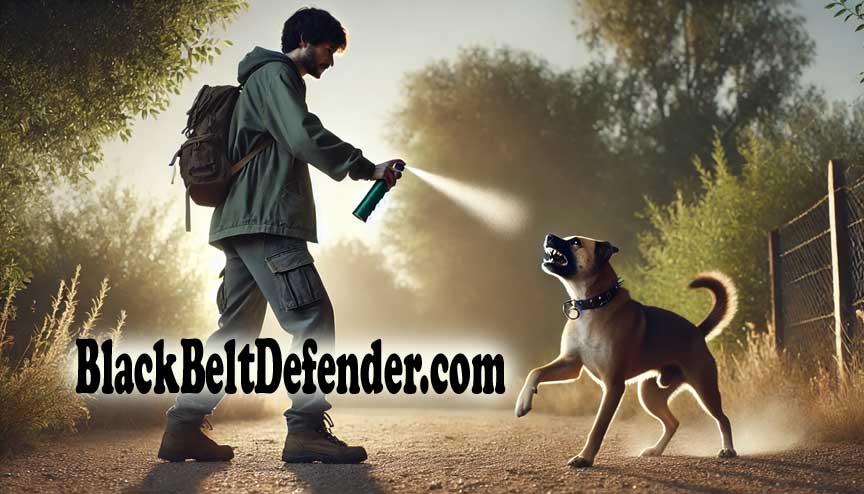
free shipping on orders over $49
We're having a 15% off sale on all our products. Enter your email below to be notified about future sales.




Yes, pepper spray can stop a dog attack by causing immediate, intense discomfort, making it an effective non-lethal self-defense tool. It forces a dog’s eyes to shut and restricts breathing, which can momentarily incapacitate them without causing long-term harm. You’ll want to aim for the eyes and maintain a safe distance when deploying it. Remember, using pepper spray responsibly is important, treating it as a last resort to guarantee your safety and the dog’s well-being. Proper preparation and understanding of how to use it can significantly enhance your confidence in handling potential threats. Discovering alternative methods and safety measures could offer further peace of mind.
Every year, approximately 4.5 million people in the U.S. fall victim to dog bites, highlighting an important issue affecting individuals across all age groups. It’s a startling statistic that underscores the reality of dog attacks as a common occurrence, touching the lives of young children to senior citizens. You might find it surprising that most dog bites come from resident dogs, not the pets you’re familiar with, but those in your immediate surroundings. This fact alone can make you rethink the safety of your neighborhood walks or your child’s playtime in the park.
Interestingly, stray dogs pose a higher risk of attacking individuals compared to pets. This distinction is significant when considering your defense options, such as carrying pepper spray, which could provide a non-lethal means to protect yourself in the event of a dog attack. The prevalence of dog attacks, affecting a broad spectrum of the population, calls for an effective strategy to mitigate these incidents. Understanding the statistics behind dog bites can empower you to make informed decisions about your safety and the use of pepper spray as a defensive tool against potential dog attacks.
Understanding the composition and effects of pepper spray is essential when considering it as a defense against dog attacks. At its core, pepper spray contains oleoresin capsicum (OC), a potent compound that triggers an intense burning sensation and can even cause temporary blindness. This reaction is thanks to capsaicin, the active ingredient derived from chili peppers, which is what gives the spray its incapacitating power.
When you’re facing a dog attack, deploying pepper spray can effectively stop the dog in its tracks. The spray works by forcing the dog’s eyes to close and by constricting its breathing passages. This immediate physical response can halt an attack, providing you with an important moment to escape or seek help. However, it’s crucial to remember that reactions to pepper spray can vary among dogs. Some might be more sensitive than others, making caution and proper deployment key factors in successfully deterring an attack.
Always remember the importance of maintaining a safe distance from the dog when using pepper spray. It’s a last resort option that requires precision and awareness of the situation to ensure your safety and minimize harm to the animal.
You might wonder how pepper spray affects a dog during and after an encounter.
Let’s explore its immediate reaction times and consider any long-term health impacts on the dog.
Understanding these effects is essential to using pepper spray responsibly and effectively in defense situations.
When sprayed with pepper spray, dogs immediately experience severe discomfort, reacting within seconds to its potent irritants. This rapid reaction is essential for protecting against dog attacks, as the spray targets the eyes and skin, causing temporary incapacitation. The effects can last for hours, giving you a significant window of safety.
| Factor | Impact on Reaction Time | Note |
|---|---|---|
| Dog Size | Variable | Larger dogs may react slower |
| Breed | Variable | Some breeds are more resilient |
| Proximity to Spray | Immediate | Closer proximity, quicker effect |
Pepper spray’s immediate impact deters aggressive behavior, preventing potential harm. It’s a swift solution that varies with the dog’s size, breed, and how close they are to the spray.
Pepper spray, while causing temporary discomfort, doesn’t lead to long-term health issues in dogs. When you’re faced with an aggressive dog, using dog spray as a form of self-defense can incapacitate the animal for hours due to irritation to its eyes, nose, and skin.
Importantly, this method prevents the situation from escalating without causing lasting harm to the dog. It’s essential to recognize that pepper spray is a non-lethal option, offering a humane alternative to protect yourself. This tool not only stops a dog attack effectively but also safeguards the animal doesn’t suffer permanent health impacts.
Regarding self-defense, pepper spray stands out as a valuable asset in safeguarding personal safety while being considerate of the dog’s well-being.
As you consider using pepper spray for dog attacks, it’s important to know effective defense techniques and have an emergency response plan in place.
Ensuring you’re prepared can greatly increase your safety and effectiveness in these high-stress situations. Let’s explore how to responsibly use pepper spray and what steps to take immediately after an encounter.
In facing a dog attack, deploying pepper spray effectively can serve as an important defense technique, ensuring your safety while minimizing harm to the animal. When an attacking dog confronts you, it’s essential to remain calm and aim the spray directly at the dog’s eyes to maximize the chance of stopping the attack swiftly. Remember, the goal is to create an opportunity for you to escape, not to injure the animal severely.
| Action | Target | Outcome |
|---|---|---|
| Deploy Spray | Attacking Dog’s Eyes | Temporary Incapacitation |
| Maintain Distance | Between You and Dog | Safety & Effective Defense |
| Aim Carefully | Eyes of the Dog | Immediate Disorientation |
| Use Sparingly | As Last Resort | Minimize Harm |
Responsible use of pepper spray, with an emphasis on safety and minimizing harm, is key to defending yourself effectively.
Having a clear emergency response plan that includes the use of pepper spray is crucial for your safety during a dog attack. Knowing how to use pepper spray effectively can offer peace of mind if you’re concerned about aggressive dogs.
Pepper spray stops a dog in its tracks by causing temporary irritation to the eyes, nose, and skin, allowing you to escape. It’s a safe, reliable defense that doesn’t cause long-term harm to the animal.
To make sure you’re prepared, practice using pepper spray ahead of time. This training boosts your confidence and ensures you can act quickly in an emergency.
You can deter an aggressive dog by employing alternative defense methods such as hitting its nose or eyes, pulling on its scruff, or creating distance. While pepper spray is a highly effective tool, these alternative defense methods provide options when it’s not available or if you’re looking for a non-chemical means to protect yourself. Being prepared and aware of your surroundings can greatly enhance your safety.
Here’s a quick guide to alternative defense methods you can use:
| Method | Description |
|---|---|
| Hitting Nose or Eyes | Temporarily disorients the dog, giving you time to escape. |
| Pulling on Scruff | Mimics dominance, potentially calming an aggressive dog. |
| Creating Distance | Puts space between you and the dog, reducing threat. |
| Protective Gear | Wearing heavy fabric or specialized vests can provide a barrier. |
Before carrying pepper spray for defense against dog attacks, it’s important to understand the legal framework governing its use in your area. Across the United States, pepper spray is legal for individuals 18 years old or older to carry for self-defense. However, there’s a caveat you can’t overlook; local laws and regulations may have specific stipulations regarding its use on animals.
You must be aware that pepper spray should only be used as a last resort when facing an aggressive animal. It’s not a tool for training or disciplining pets. Misuse or abuse of pepper spray, including employing it for purposes other than self-defense, is strictly prohibited.
Considering pepper spray as a humane and effective means of protection, it’s important to use it responsibly. Familiarize yourself with the guidelines and legalities in your locality to make sure you’re within your rights when you decide to carry pepper spray. Remember, while it’s available for your safety, its use is regulated to make sure it’s not misapplied or used harmfully. Being informed and prepared can make all the difference in safely handling a potential dog attack scenario.
Numerous real-life incidents have demonstrated the effectiveness of pepper spray in thwarting dog attacks, ensuring both human and animal safety. You’ve likely heard stories or maybe even know someone who’s faced an aggressive dog. The quick action of using pepper spray has often turned these potentially dangerous situations into manageable ones, preventing serious dog bites and harm.
To give you a clearer picture, here’s a table summarizing some key points from various testimonials and reports:
| Situation | Outcome | Key Benefit |
|---|---|---|
| Jogger approached by aggressive dog | Dog deterred, jogger unharmed | Prevented potential injuries |
| Mail carrier facing daily threats | Uses pepper spray, no further incidents | Safe delivery of mail |
| Hiker encounters a unrestrained dog | Dog retreats after spray use | Hiker continues safely |
| Neighbor’s dog becomes aggressive | Pepper spray defuses situation | Avoids harm and maintains neighborly relations |
| Dog park confrontation | Quick use of spray prevents fight | Protects pets and owners |
These incidents highlight how carrying pepper spray can be a game-changer in avoiding dog bites and ensuring safety. It’s clear that having pepper spray as a defensive tool not only offers peace of mind but also provides a humane and effective way to stop dog attacks before they result in injury.
After stopping a dog attack with pepper spray, immediately find a secure area to prevent further danger. This step is vital for your safety and to assess any injuries you might’ve sustained during the incident.
Once you’re in a safe location, it’s important to seek medical attention, especially if you’ve been bitten or scratched. Injuries from dog attacks can lead to serious infections, and consulting with professionals promptly ensures you’re following the best practices outlined by Disease Control guidelines.
Next, you’ll need to wash any affected areas with soap and water to remove the pepper spray residue from your skin. Be careful not to rub your eyes or face after using pepper spray, as this can cause further irritation. To aid in this process, refer to the Guide to Pepper Spray Aftercare for detailed instructions on cleaning and minimizing discomfort.
You’re probably wondering if pepper spray can stop a pitbull attack. It can, due to the intense pain it causes. But, consider pitbull behavior and legal implications before using it as a defense method.
In a dog fight, pepper spray can be a tool for self-defense, but you should take into account safety concerns and legal implications. It’s effective, yet make sure it’s a last resort and know your local laws.
The best deterrent for dog attacks combines effective training methods with reliable fencing options, ensuring dogs are well-behaved and securely contained. This approach minimizes risks and keeps both pets and people safe.
You can spray water or use noise distraction to stop dogs from fighting. These methods offer a safe, effective solution without the risks associated with pepper spray, keeping both you and the dogs safe.
As always, be safe and be prepared.
See Also:
Black Belt Defender
1867 Caravan Trail #105
Jacksonville, FL 32216-2006
Call us toll-free: (800) 859-5566
Mon-Fri: 9:00 am – 5:00 pm EST
NH based, FL Warehouse
Online Orders: 24/7/365

